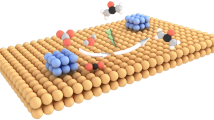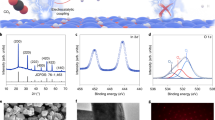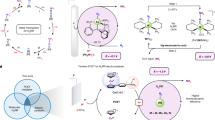Abstract
The urea industry is energy intensive and responsible for high levels of carbon emissions. Electrocatalytic co-reduction of carbon dioxide (CO2) and nitrate (NO3−) powered by renewable energy offers an alternative and sustainable synthetic pathway to this chemical that is vital in agriculture, chemical engineering and other fields, but the yield rate cannot compete with the state-of-the-art petrochemical processes. Here we show a urea electrosynthesis route using an iron tetraphenylporphyrin molecular electrocatalyst that delivers a maximum Faradaic efficiency of 27.70% for urea while suppressing the competing hydrogen evolution reaction. At the heart of our strategy is electrolysis under pulsed potentials between −0.2 and −0.8 V versus the reversible hydrogen electrode, which increases the local concentration of CO2/NO3− but reduces the local pH to enrich *CO and *NH2 intermediates favoured by C–N coupling. Importantly, our strategy can be applied to more catalyst systems such as ZnO and PdCu, and save more than 41% energy consumption compared with static co-electrolysis, with PdCu enabling a maximum urea Faradaic efficiency of 70.36% for pulsed electrolysis. Our work opens an avenue for efficient urea production and provides insights into the role of the local reaction environment, which can inform the rational design of electrocatalysts.
This is a preview of subscription content, access via your institution
Access options
Access Nature and 54 other Nature Portfolio journals
Get Nature+, our best-value online-access subscription
$29.99 / 30 days
cancel any time
Subscribe to this journal
Receive 12 digital issues and online access to articles
$119.00 per year
only $9.92 per issue
Buy this article
- Purchase on Springer Link
- Instant access to full article PDF
Prices may be subject to local taxes which are calculated during checkout





Similar content being viewed by others
Data availability
All data required to evaluate the conclusions of the paper are present in the paper and/or Supplementary Information. Source data are provided with this paper.
References
Chen, C. et al. Coupling N2 and CO2 in H2O to synthesize urea under ambient conditions. Nat. Chem. 12, 717–724 (2020).
Li, J., Zhang, Y., Kuruvinashetti, K. & Kornienko, N. Construction of C–N bonds from small-molecule precursors through heterogeneous electrocatalysis. Nat. Rev. Chem. 6, 303–319 (2022).
Lv, C. et al. Selective electrocatalytic synthesis of urea with nitrate and carbon dioxide. Nat. Sustain. 4, 868–876 (2021).
Peng, X. et al. Electrochemical C–N coupling of CO2 and nitrogenous small molecules for the electrosynthesis of organonitrogen compounds. Chem. Soc. Rev. 52, 2193–2237 (2023).
Wei, X. et al. Oxygen vacancy-mediated selective C–N coupling toward electrocatalytic urea synthesis. J. Am. Chem. Soc. 144, 11530–11535 (2022).
Zhang, X. et al. Identifying and tailoring C–N coupling site for efficient urea synthesis over diatomic Fe–Ni catalyst. Nat. Commun. 13, 5337 (2022).
Zhao, Q. et al. Sustainable and high-rate electrosynthesis of nitrogen fertilizer. Angew. Chem. Int. Ed. 62, e202307123 (2023).
Zhang, X. et al. Electrocatalytic urea synthesis with 63.5% Faradaic efficiency and 100% N-selectivity via one-step C–N coupling. Angew. Chem. Int. Ed. Engl. 62, e202305447 (2023).
Yuan, M. et al. Highly selective electroreduction of N2 and CO2 to urea over artificial frustrated Lewis pairs. Energy Environ. Sci. 14, 6605–6615 (2021).
Lv, Z. et al. Coactivation of multiphase reactants for the electrosynthesis of urea. Adv. Energy Mater. 13, 2300946 (2023).
Leverett, J. et al. Tuning the coordination structure of Cu–N–C single atom catalysts for simultaneous electrochemical reduction of CO2 and NO3– to urea. Adv. Energy Mater. 12, 2201500 (2022).
Wang, H. et al. Realizing efficient C–N coupling via electrochemical co-reduction of CO2 and NO3– on AuPd nanoalloy to form urea: key C–N coupling intermediates. Appl. Catal. B 318, 121819 (2022).
Zhao, Y. et al. Efficient urea electrosynthesis from carbon dioxide and nitrate via alternating Cu–W bimetallic C–N coupling sites. Nat. Commun. 14, 4491 (2023).
Meng, N. et al. Oxide-derived core–shell Cu@Zn nanowires for urea electrosynthesis from carbon dioxide and nitrate in water. ACS Nano 16, 9095–9104 (2022).
Huang, Y. et al. Direct electrosynthesis of urea from carbon dioxide and nitric oxide. ACS Energy Lett. 7, 284–291 (2022).
Wang, D., Chen, C. & Wang, S. Defect engineering for advanced electrocatalytic conversion of nitrogen-containing molecules. Sci. China Chem. 66, 1052–1072 (2023).
Meng, N., Huang, Y., Liu, Y., Yu, Y. & Zhang, B. Electrosynthesis of urea from nitrite and CO2 over oxygen vacancy-rich ZnO porous nanosheets. Cell Rep. Phys. Sci. 2, 100378 (2021).
Lv, C. et al. A defect engineered electrocatalyst that promotes high-efficiency urea synthesis under ambient conditions. ACS Nano 16, 8213–8222 (2022).
Geng, J. et al. Ambient electrosynthesis of urea with nitrate and carbon dioxide over iron-based dual-sites. Angew. Chem. Int. Ed. 135, e202210958 (2023).
Liu, Y. et al. C-bound or O-bound surface: which one boosts electrocatalytic urea synthesis? Angew. Chem. Int. Ed. 135, e202300387 (2023).
Zhang, S.-B. et al. High-efficiency electrosynthesis of urea over bacterial cellulose regulated Pd–Cu bimetallic catalyst. EES Catal. 1, 45–53 (2023).
Cao, N. et al. Oxygen vacancies enhanced cooperative electrocatalytic reduction of carbon dioxide and nitrite ions to urea. J. Colloid Interface Sci. 577, 109–114 (2020).
Krzywda, P. M., Paradelo, Rodríguez, A., Benes, N. E., Mei, B. T. & Mul, G. Carbon–nitrogen bond formation on Cu electrodes during CO2 reduction in NO3– solution. Appl. Catal. B 316, 121512 (2022).
Liu, M. et al. Enhanced electrocatalytic CO2 reduction via field-induced reagent concentration. Nature 537, 382–386 (2016).
Liu, D. et al. Atomically dispersed platinum supported on curved carbon supports for efficient electrocatalytic hydrogen evolution. Nat. Energy 4, 512–518 (2019).
Mi, L. et al. Achieving synchronization of electrochemical production of ammonia from nitrate and ammonia capture by constructing a “two-in-one” flow cell electrolyzer. Adv. Energy Mater. 12, 2202247 (2022).
Zhang, X.-D. et al. Asymmetric low-frequency pulsed strategy enables ultralong CO2 reduction stability and controllable product selectivity. J. Am. Chem. Soc. 145, 2195–2206 (2023).
Timoshenko, J. et al. Steering the structure and selectivity of CO2 electroreduction catalysts by potential pulses. Nat. Catal. 5, 259–267 (2022).
Chang, C.-J. et al. Lewis acidic support boosts C–C coupling in the pulsed electrochemical CO2 reaction. J. Am. Chem. Soc. 145, 6953–6965 (2023).
Zhang, X. et al. Molecular engineering of dispersed nickel phthalocyanines on carbon nanotubes for selective CO2 reduction. Nat. Energy 5, 684–692 (2020).
Costentin, C., Drouet, S., Robert, M. & Saveant, J.-M. A local proton source enhances CO2 electroreduction to CO by a molecular Fe catalyst. Science 338, 90–94 (2012).
Zhang, W.-D. et al. Fe single-atom catalysts with pre-organized coordination structure for efficient electrochemical nitrate reduction to ammonia. Appl. Catal. B 317, 121750 (2022).
Wu, Y., Jiang, Z., Lin, Z., Liang, Y. & Wang, H. Direct electrosynthesis of methylamine from carbon dioxide and nitrate. Nat. Sustain. 4, 725–730 (2021).
Liu, X., Jiao, Y., Zheng, Y., Jaroniec, M. & Qiao, S.-Z. Mechanism of C–N bonds formation in electrocatalytic urea production revealed by ab initio molecular dynamics simulation. Nat. Commun. 13, 5471 (2022).
Kim, C., Weng, L.-C. & Bell, A. T. Impact of pulsed electrochemical reduction of CO2 on the formation of C2+ products over Cu. ACS Catal. 10, 12403–12413 (2020).
Bui, J. C., Kim, C., Weber, A. Z. & Bell, A. T. Dynamic boundary layer simulation of pulsed CO2 electrolysis on a copper catalyst. ACS Energy Lett. 6, 1181–1188 (2021).
Wang, X. et al. Anomalous hydrogen evolution behavior in high-pH environment induced by locally generated hydronium ions. Nat. Commun. 10, 4876 (2019).
Zhang, D., Xue, Y., Zheng, X., Zhang, C. & Li, Y. Multi-heterointerfaces for selective and efficient urea production. Natl Sci. Rev. 10, nwac209 (2023).
Zhu, S., Jiang, B., Cai, W.-B. & Shao, M. Direct observation on reaction intermediates and the role of bicarbonate anions in CO2 electrochemical reduction reaction on Cu surfaces. J. Am. Chem. Soc. 139, 15664–15667 (2017).
Sun, K. et al. Interfacial water engineering boosts neutral water reduction. Nat. Commun. 13, 6260 (2022).
Gupta, N., Gattrell, M. & MacDougall, B. Calculation for the cathode surface concentrations in the electrochemical reduction of CO2 in KHCO3 solutions. J. Appl. Electrochem. 36, 161–172 (2006).
Chen, G. et al. CoS2 needle arrays induced a local pseudo-acidic environment for alkaline hydrogen evolution. Nanoscale 13, 13604–13609 (2021).
Shah, A. H. et al. The role of alkali metal cations and platinum-surface hydroxyl in the alkaline hydrogen evolution reaction. Nat. Catal. 5, 923–933 (2022).
Chen, F.-Y. et al. Efficient conversion of low-concentration nitrate sources into ammonia on a Ru-dispersed Cu nanowire electrocatalyst. Nat. Nanotechnol. 17, 759–767 (2022).
Acknowledgements
This work was supported by the National Natural Science Foundation of China (U21A20312, 22379100, 22309115), the Shenzhen Science and Technology Program (grant numbers 20231121200418001, RCYX20200714114535052) and the Guangdong Basic and Applied Basic Research Foundation (2022B1515120084). We also acknowledge the help of the Electron Microscopy Centre of Shenzhen University in testing the HAADF-STEM.
Author information
Authors and Affiliations
Contributions
C.H. conceived the idea and directed the project. Q. Hu designed the experiments and wrote the paper. W.Z., S.Q., Q. Huo, X.L., M.L. and X. Chen performed the experiments. Q. Hu, W.Z., C.F., J.Y., X. Chai and H.Y. analysed the data.
Corresponding author
Ethics declarations
Competing interests
The authors declare no competing interests.
Peer review
Peer review information
Nature Sustainability thanks Dehui Deng, Min-Rui Gao and the other, anonymous, reviewer(s) for their contribution to the peer review of this work.
Additional information
Publisher’s note Springer Nature remains neutral with regard to jurisdictional claims in published maps and institutional affiliations.
Supplementary information
Supplementary Information
Supplementary Notes 1 and 2, Figs. 1–48, Tables 1–4 and References.
Source data
Source Data Fig. 1
Structural characterization.
Source Data Fig. 2
Electrochemical performance characterization.
Source Data Fig. 3
Operando mass spectrum.
Source Data Fig. 4
Operando ATR-SEIRAS spectroscopy measurements.
Source Data Fig. 5
Simulation calculations.
Rights and permissions
Springer Nature or its licensor (e.g. a society or other partner) holds exclusive rights to this article under a publishing agreement with the author(s) or other rightsholder(s); author self-archiving of the accepted manuscript version of this article is solely governed by the terms of such publishing agreement and applicable law.
About this article
Cite this article
Hu, Q., Zhou, W., Qi, S. et al. Pulsed co-electrolysis of carbon dioxide and nitrate for sustainable urea synthesis. Nat Sustain 7, 442–451 (2024). https://doi.org/10.1038/s41893-024-01302-0
Received:
Accepted:
Published:
Issue Date:
DOI: https://doi.org/10.1038/s41893-024-01302-0



